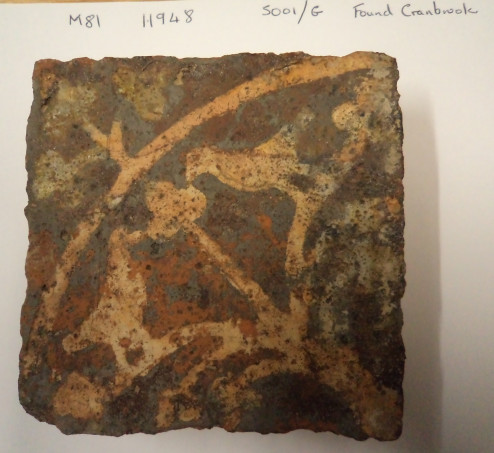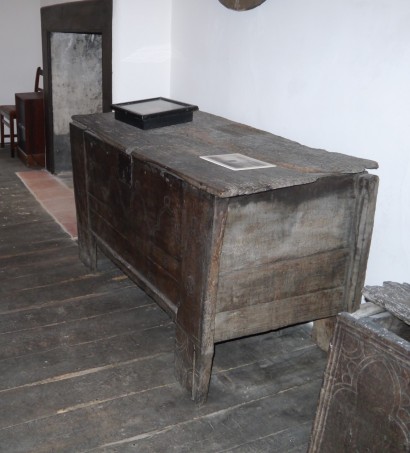This week really will be shorter for a change as I want to bring you a bit more information about forthcoming events involving people from the CKHH and organisations we work with and then a couple of snippets from the archives.
So to begin using the press release for the new ‘Lives in Our Landscape’ exhibition gallery at Maidstone Museum that will open to the public next Wednesday 5 June, I’ll be going to the opening the day before as one of those who helped select the artefacts for this “exciting new family-friendly gallery that will tell the story of how people have lived in the area over a vast span of time. Objects dating back more than 600,000 years will be on show, from the earliest type of humans hunting animals with stone tools in a forested landscape, up to the medieval period, when Maidstone became a bustling market town.” For as Natalie Moor, the Maidstone Museum Manages says: “The gallery will transport people through time and allow them to imagine how a person lived thousands of years ago. The skeleton and film of the Eastry woman, buried nearly 1,500 years ago is a great example of this. They tell her story and give clues about her life through scientific analysis of her teeth and bones.

Another great example is the recreation of what a man from the 15th century could have looked like after a skull from Trottiscliffe has been scanned and investigated. Visitors to the new gallery will be able to look into the face of someone who lived around 600 years ago. Maidstone Museum is free to visit and we look forward to welcoming you to see all the wonderful artefacts which tell us so much about our past.”
Also next week, and this time back in Canterbury, I’ll be going to the Levelling Up Fund stakeholder drop-in session on Friday. For one of the strands of the ‘Connected Canterbury: Unlocking the Tales of England’ project is the creation of nine story gardens in Canterbury. Canterbury City Council has appointed HTA Design to design and landscape the gardens and Simon Leach Design to draw out and gather the stories for each garden. Moreover, the idea is to highlight stories that you won’t find in the city guidebook, thereby bringing new and different episodes of Canterbury’s history to the attention of residents and visitors alike.

Slightly later in the month we will come to the University of Kent’s MEMSFest that is now in its 10th year and this year will be taking place on Friday 14th and Saturday 15th June, please see full details: [ https://memsfestival.wordpress.com/about/programme/ ]. As reported last week, three members of the CCCU Kent History Postgraduates will be providing a session and now that the programme is out, I can bring you the details. So on the Saturday and starting at 10.15 will be their panel entitled ‘Place and Performance: Networks in late Tudor and early Jacobean Kent’. This will comprise presentations by Jason Mazzocchi on ‘The Company of Free Fishermen and Dredgermen of Faversham 1580–1600’, then Kaye Sowden on ‘The Extended Yeomanry Branches within the Community of Pluckley 1500–1650’ and finally Kieron Hoyle, who will explore ‘The Tudor Improvements of the Port of Dover’.
In some ways this is the next stage from giving presentations within the Kent History Postgraduates group and for June the group will be hearing from first Lizzie Burton on her research investigating emotions concerning the poor during the period 1600 and 1800, and how they coped with poverty; and later in June from Kieron Hoyle concerning her project on the role of the Maison Dieu in Dover from its last decades as a pilgrim hospital and its appropriation by the Crown to become the naval victualling yard for the port. This will give Kieron a trial run for her presentation in July at Dover Museum as part of the ongoing programme events linked to the restoration project of the Maison Dieu – more on this in future weeks.

Just as a quick note, in late June the Association for Manuscripts and Archives in Research Collections (AMARC) Summer Meeting and AGM [ https://amarcsite.wordpress.com/meetings/forthcoming-meetings/ ]will be held in Canterbury under the title ‘Canterbury Cathedral: Manuscript and Print in Archive Collections’. This is an excellent opportunity to bring together Canterbury Cathedral Archives & Library and the two Canterbury-based universities in the form of MEMS at Kent and CKHH at CCCU. As the programme says, “the meeting will explore the rich collections of manuscript and print materials in the Canterbury city and cathedral archive collections housed at Canterbury Cathedral ranging in date from the Anglo-Saxon period to the eighteenth century, with talks by leading scholars: Rob Gallagher, David Rundle and David Shaw from the University of Kent, while I’ll be exploring the civic archive. Also included in the day will be curator-led tours of the historic library, and lunch at the Cathedral Lodge.” If this sounds of interest, please contact Dr Alison Ray at alison.ray@spc.ox.ac.uk .
Just arrived, the Historical Association, Canterbury branch, June lecture will be given by Professor Louise Wilkinson on Thursday 13 June at 7pm in the Michael Berry Lecture Theatre, Old Sessions, CCCU. Her title is ‘Long Live the Empress! The imperial marriage of Isabella of England, Henry III’s sister, and her progress through Kent in 1235‘. In her talk she will tell the remarkable story of Isabella of England, the second daughter of King John, who in May 1235 travelled through Kent on her way to Europe to marry the Emperor Frederick II thus becoming Holy Roman Empress and Queen of Sicily, Italy and Germany. Louise is Professor of Medieval Studies at the University of Lincoln. Before moving to Lincoln, she was Professor of Medieval History at Canterbury Christ Church University. Louise is the author of various books and articles about women, children and families in thirteenth-century England, including The Household Roll of Eleanor de Montfort, Countess of Leicester and Pembroke, 1265 (Woodbridge, 2020) and Eleanor de Montfort: The Rebel Countess (London, 2012). She has appeared on three episodes of BBC Radio 4’s In Our Time and featured in Melvyn Bragg’s 2015 radio series on Magna Carta.
Admission is free for members and students. £5 for everybody else. Membership for the year is £10 and includes free entry to all talks.
To finish off for this week, I thought I would stay with food and drink in medieval Canterbury because these meetings and conferences mention lunch, so even though these bequests relate to funerals or other acts of commemoration, the provision of hospitality was a key ingredient. My first concerns Roger Rydle, an important civic officer in Canterbury during the later 15th century. As a parishioner at St Mildred’s, it is perhaps not surprising that his will contains a bequest of 3s4d for wine for the abbot of St Augustine’s abbey. Moreover, as well as a penny to be given to each pauper over the age of 12 at his death and month’s mind, they were similarly to receive a half-penny loaf of bread. These might be seen as staples and indicators of the differing status between the abbot and the poor, but a far rarer bequest was included by Thomas Wesynden of St Mary Northgate parish on the other side of the city in the same period. For Thomas stipulated that 8s was to be used to purchase ‘ostrys and wine’ to be given to ‘my masters’, the monks at Christ Church priory with the proviso that they should sing for Thomas’ soul. Other choices, especially bread and ale might be seen as standard on such occasions, but the addition of cheese seems to have been reasonably common, as was designated by Joan Cultener of Holy Cross parish. While at St John’s hospital, Canterbury, this was apparently the expected fare at the commemoration of deceased brothers and sisters, such feasting presumably taking place in the hospital’s refectory.

Whether Maidstone Museum will provide anything comparable at their exhibition launch, I’ll let you know next week.
 Centre for Kent History and Heritage
Centre for Kent History and Heritage Sheila Sweetinburgh
Sheila Sweetinburgh 1346
1346


